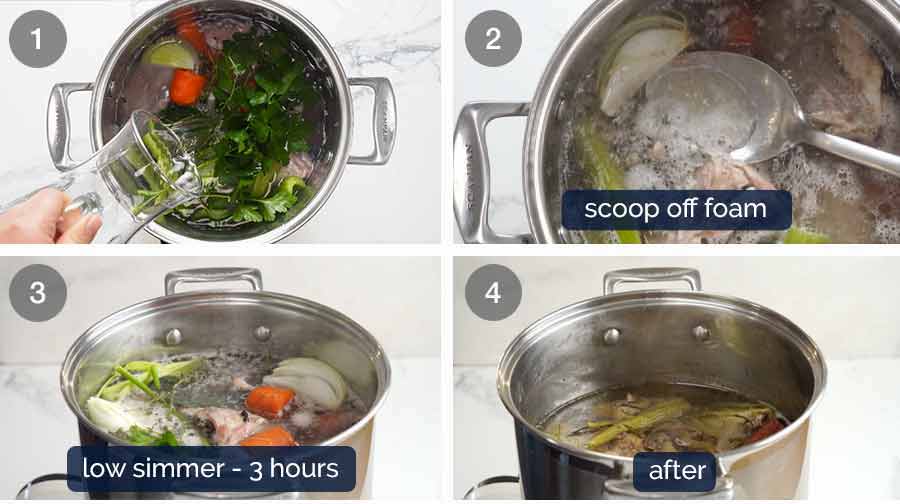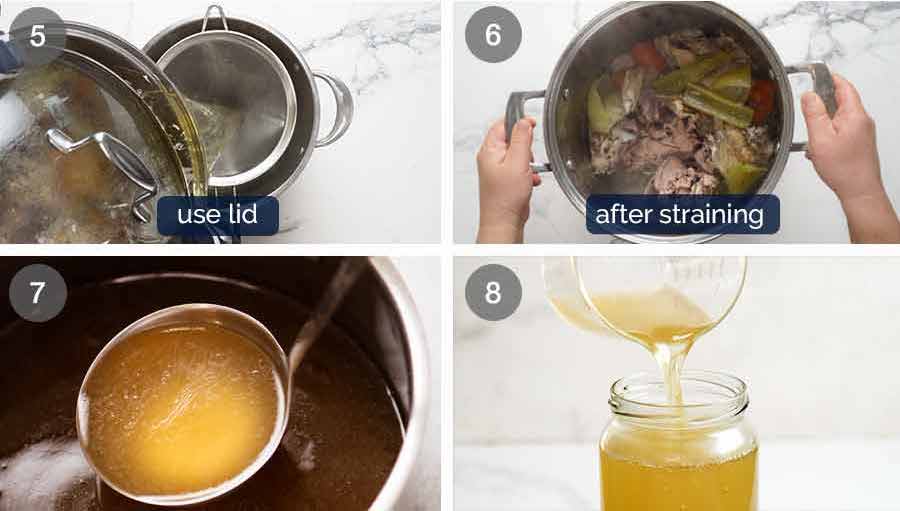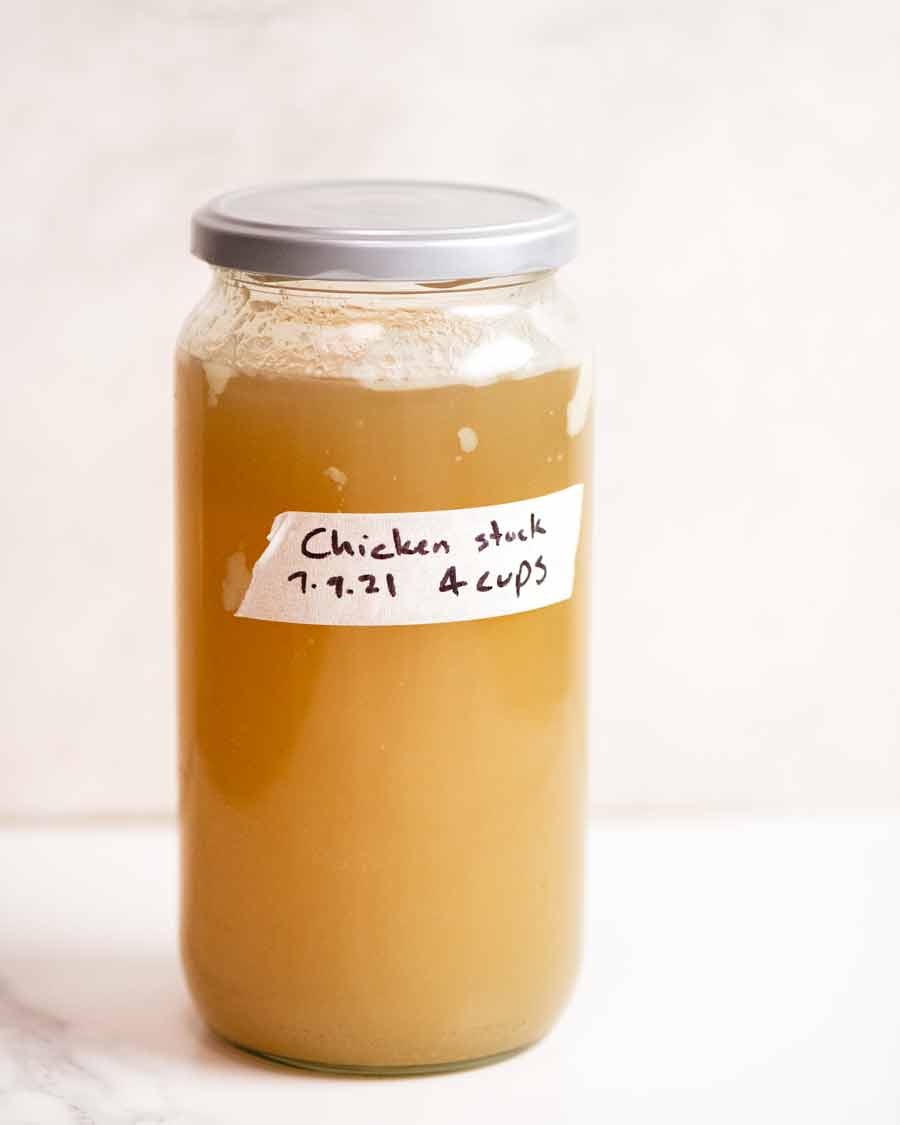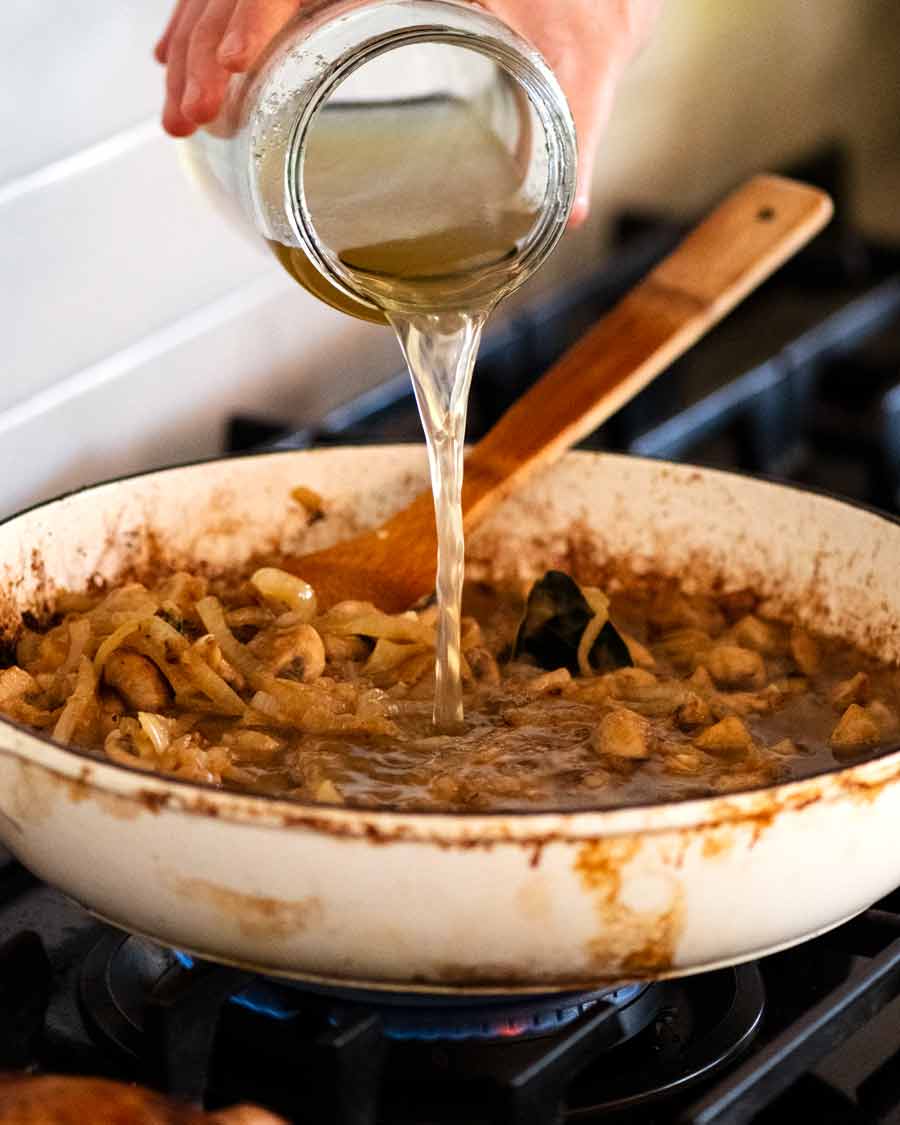This is the only chicken stock recipe you’ll ever need. It’s an excellent all-rounder that’s nice and clear, with the ideal balance of flavour, nutrients and richness. Use it for everything from clear soups to rich stews, gravies and creamy sauces.
I like making chicken stock because it’s easy compared to beef stock, and improves just about everything – the main goal here!
Stocks are the foundation for countless dishes in many cuisines. Chicken stock is one of the most common and versatile stocks in Western cooking, and is made by infusing water with the flavours of chicken, fresh root vegetables and herbs. Good restaurants always make their own stocks, and is the secret to why their dishes often have that richer, deeper, “restaurant-quality” taste to them!
The longer you simmer, the more collagen and other goodness you wall extract form the bones. While some people claim that anything short of 48 hours isn’t enough, I think that simmering for this long is a bit redundant. So simmer as long as you wish, but about 6 hours is bare minimum.

Why I don’t use other chicken cuts for stock
Here are my thoughts on other chicken cuts that are sometimes used for chicken stock:
- Breast – I just think it’s wasteful. The cooked chicken is flavourless and stripped of all nutrition, because it’s given up all its goodness to the stock. So you can’t really use the spent meat for anything except maybe filler in strongly flavoured foods, or perhaps giving it to your dog! Also, because chicken breast is fairly neutral in flavour, you need a lot to extract enough flavour to make a decent stock.
- Skin-on, bone-in chicken pieces, like thigh and drumsticks – While they make very flavourful stocks, the skin and fat makes the stock greasy and there will be quite a slick of oil floating on top of the stock. This is a little too fatty for many purposes, such as making nice clear chicken noodle soups.
- Wing tips – Wing tips are packed with gelatin and flavour, being a dark meat. If you’ve got some, throw them in! But to make a whole batch of chicken stock, you’d need a LOT of wing tips.
- Chicken feet – This will add a lot of gelatin into the stock so it wouldn’t hurt to throw some in (say 4 to 6) for extra richness. I think if you made a whole batch of stock using just feet it would be far too gelatinous!
- Whole chicken – I find that you can’t extract enough flavour from a whole chicken for the amount of water required to cover it completely to make a proper flavourful stock. In fact, even when making a traditional chicken noodle soup using a whole chicken, I always add a small touch of stock powder to give the soup stock a little boost. Otherwise, it’s just a bit bland!
- Giblets – Giblets refers to the heart, liver and gizzards of chicken that are sometimes bundled up and stuffed inside the cavity of store bought whole chicken. They are provided with the intention to make gravies and sauces. If you have some, by all means throw them in with the bones! I would not make a stock with just a big bag of giblets however, as it will be quite offal-ly!
- Frame of cooked whole chicken – The carcass of a roast chicken will not provide enough flavour for homemade chicken stock. I’ve tried multiple times over the years! You just can’t get nearly enough flavour out of it for the amount of water required to cover it.
How to make chicken stock
Because we’re making a nice clear white chicken stock (see above), there’s no bone-roasting malarkey to take care of first which makes the whole process much quicker and less laborious. Just dump everything in a pot, add water and simmer!

- Put everything in a large stock pot – Place the chicken carcasses, vegetables, herbs and water in a large 7 litre /7 quart stock pot. 3 litres / 3 quarts of water should just about cover everything. If not, do a bit of pushing and poking to rearrange the carcasses and ingredients more snugly in the pot. Try not to break or crush the bones else this will make the stock murkier.We want everything submerged so the water gets infused with flavour. Don’t worry if some of the bones are poking above the water surface. The carcasses will collapse once it starts cooking and end up under the water.
- Scoop off scum – Bring the pot to a rapid simmer over medium-high heat. As it starts getting hot, you will see foam on the surface which is the impurities in the chicken. Scoop it off and discard to keep your stock nice and clear.
- Simmer 3 hours – Once the water comes to a rapid simmer, lower the heat so it’s bubbling very gently. Then leave to simmer for 3 hours with the lid off.
- After simmering – The photo above shows the water level after 3 hours. It has reduced by around 1/3.Your chicken stock is done! Now we just need to strain it, remove excess fat (if you want) and store it! Here’s how:

- Strain – Using the lid of the pot to hold back the bones and vegetables in the pot, strain the stock through a fine mesh strainer into another pot or large bowl. I use a pot in case I need to reduce it to the right amount (see below).. If you’re not strong or comfortable with the lid method, just fish out the solids with tongs or a large straining spoon before pouring the remaining liquid through a sieve.The goal: To end up with 2 litres / 2 quarts of chicken stock. In a perfect world, you will end up with 2 litres / 2 quarts of chicken stock. But it is rarely a perfect world! And that’s ok. If you have less, than this just top up with water. If you ended up with more than about 2.25 litres / quarts, then reduce it on the stove, else you run the risk of a weak-flavoured chicken stock.
- Leftover bones and vegetables – These have been well stripped of flavour and nutrition, so they aren’t really that useful. However, I do pick off excess meat for Dozer! But after that, I just discard the remnants.
- Voila! Admire your beautiful and clear chicken stock!
- Divide between storage containers – At this point, I divide the stock up into jars or containers which allows the stock to cool faster.I store my chicken stock in 1 cup multiples which I find quite handy for use. Always label your containers with the quantity of chicken stock and date you made it!

- Cool then refrigerate – Once the stock is cooled to room temperature, place them in the fridge to fully cool. Never put hot stock in the fridge!
- Solidified fat – As the stock cools, the fat will rise to the surface. Once fully cold, the fat solidifies and turns into a white sheet of solid fat on the surface of the stock, like a frozen-over lake.You will also notice that the chicken stock firms up into a jelly-like consistency when cold. This is due to the gelatin. We want gelatin – it’s what gives the stock a delicious, lip-sticking, rich mouthfeel you don’t get in store-bought stock (ever notice how store-bought stock never sets like this in the fridge?) So basically, jelly consistency = good stock!
- Scrape off fat – Scrape the fat off the surface using a spoon and discard. This is actually an optional step. It makes the stock light and clean, making it a great all-rounder that can be used for everything from clear soups (like Chinese Noodle Soup) to rich sauces (like the sauce of a Creamy Chicken Pasta). For a jus or reduction sauces you should also use de-greased stock.But if you are intending to use the stock for things like stews (like this one) and creamy sauces (like Mushroom Sauce) that do not require a clear, de-greased chicken stock like we desire for things like Chicken Noodle Soup, then there is no need to remove the fat.
- Storing – Homemade stock will keep for 5 days in the fridge or for 6 months in the freezer. Fridge-cold chicken stock can be used as is, in its jelly-like state. It melts back into liquid form very quickly as soon as it’s heated.If using from frozen, thaw overnight in the fridge, microwave, or run the container under hot water to loosen, then melt in a saucepan. Though if I’m adding the stock into an already-simmering liquid sometimes I’ll just add the frozen stock block as-is! It melts fairly fast and the result is the same. I use all of these methods depending on how much time I have!
Here’s a jar of refrigerated chicken stock which has had the fat scraped off the surface.

And here it is in liquid form at room temperature. But as noted above, you can just use chicken stock in jelly form as it melts in seconds on contact with heat!

Make Your Own ‘Liquid Gold’ Chicken Stock | Epicurious 101
FAQ
Can you make chicken stock in 3 hours?
Is 3 hours enough for broth?
Can I make stock in 2 hours?
Is 4 hours long enough for stock?
How long does chicken stock take to cook?
Scoop it off and discard to keep your stock nice and clear. Simmer 3 hours – Once the water comes to a rapid simmer, lower the heat so it’s bubbling very gently. Then leave to simmer for 3 hours with the lid off. After simmering – The photo above shows the water level after 3 hours. It has reduced by around 1/3. Your chicken stock is done!
How long does chicken stock last?
Cover and refrigerate the stock for up to 3 days, or freeze for up to 3 months. Chicken stock can be simmered for as little as 1 hour or up to 8 hours. Most often, you’ll see recipes call for somewhere in between, about 3 to 4 hours. The longer the stock simmers, the more concentrated its flavor.
How long should chicken stock be simmered?
See the chicken soup video above to see the whole process. How long should I simmer chicken stock? I think 4 hours minimum can give your chicken stock a good flavor if you want to make soup and need it more quickly. If I make it on the stove, I let it simmer 4-8 hours. I almost always let it simmer 24 hours if I use a CrockPot.
How long does chicken stock last in a crock pot?
Nestle the pot into the ice bath and let the stock cool to room temperature. Cover and refrigerate the stock for up to 3 days, or freeze for up to 3 months. Chicken stock can be simmered for as little as 1 hour or up to 8 hours. Most often, you’ll see recipes call for somewhere in between, about 3 to 4 hours.
